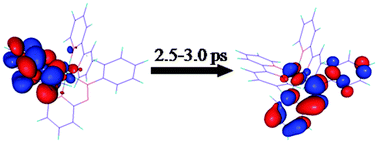Probing excited state charge transfer dynamics in a heteroleptic ruthenium complex
Abstract
Dynamics of metal to ligand charge transfer in the excited states of ruthenium polypyridyl complexes, which have shown promise as materials for artificial solar energy harvesting, has been of immense interest recently. Mixed ligand complexes are especially important for broader absorption in the visible region. Dynamics of ultrafast vibrational energy relaxation and inter-ligand charge transfer processes in the excited states of a heteroleptic ruthenium complex, [Ru(bpy)2(pap)](ClO4)2 (where bpy is 2,2′-bipyridine and pap is 2-(phenylazo)pyridine) have been investigated using femtosecond to nanosecond time-resolved transient absorption spectroscopic techniques. A good agreement between the TA spectrum of the lowest excited 3MLCT state of [Ru(bpy)2(pap)](ClO4)2 complex and the anion radical spectrum of the pap ligand, which has been generated using the pulse radiolysis technique, confirmed the charge localization at the pap ligand. While the lifetime of the inter-ligand charge transfer from the bpy to the pap ligand in the 3MLCT state is about 2.5 ps, vibrational cooling of the pap-localized3MLCT state occurs over a much longer time scale with a lifetime of about 35 ps. Ultrafast charge localization dynamics observed here may have important consequences in artificial solar energy harvesting systems, which employ heteroleptic ruthenium complexes.


 Please wait while we load your content...
Please wait while we load your content...